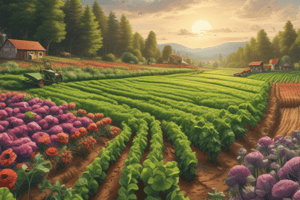Podcast
Questions and Answers
What is the main objective of subsistence farming?
What is the main objective of subsistence farming?
- To grow food for sale
- To maximize yields using technology
- To conserve natural resources
- To grow food for personal consumption (correct)
What is the primary difference between intensive and extensive farming?
What is the primary difference between intensive and extensive farming?
- The use of labor, capital, and technology (correct)
- The use of organic fertilizers
- The size of the farm
- The type of crops grown
What is the benefit of crop rotation?
What is the benefit of crop rotation?
- To promote food waste
- To raise livestock
- To increase the use of synthetic fertilizers
- To maintain soil fertility and reduce pests and diseases (correct)
What is the main goal of sustainable agriculture?
What is the main goal of sustainable agriculture?
What is the definition of food security?
What is the definition of food security?
What is the primary driver of increasing demand for food?
What is the primary driver of increasing demand for food?
What is the main difference between monoculture and polyculture?
What is the main difference between monoculture and polyculture?
What is the primary factor affecting crop growth and yield?
What is the primary factor affecting crop growth and yield?
What is the goal of reducing food waste?
What is the goal of reducing food waste?
What is the definition of food sovereignty?
What is the definition of food sovereignty?
Flashcards are hidden until you start studying
Study Notes
Types of Food Production
- Subsistence farming: Growing food for personal consumption, often on a small scale.
- Commercial farming: Growing food for sale, often on a large scale.
- Intensive farming: Using large amounts of labor, capital, and technology to maximize yields.
- Extensive farming: Using minimal labor, capital, and technology to minimize costs.
- Organic farming: Growing food without synthetic fertilizers, pesticides, or genetically modified organisms.
- Sustainable agriculture: Producing food while maintaining ecological balance and conserving natural resources.
Food Production Systems
- Monoculture: Growing a single crop on a large area of land.
- Polyculture: Growing multiple crops on the same area of land.
- Crop rotation: Rotating crops to maintain soil fertility and reduce pests and diseases.
- Livestock production: Raising animals for meat, dairy, or eggs.
- Aquaculture: Raising fish and other aquatic animals for food.
Factors Affecting Food Production
- Climate: Temperature, precipitation, and sunlight affect crop growth and yield.
- Soil: Soil quality, fertility, and water-holding capacity affect crop growth.
- Water: Availability of water for irrigation affects crop growth.
- Labor: Availability and cost of labor affect food production.
- Technology: Use of machinery, irrigation systems, and other technologies affects food production.
Food Security and Sustainability
- Food security: Access to sufficient, safe, and nutritious food to meet dietary needs.
- Food waste: Reduction of food waste to minimize environmental impact.
- Sustainable agriculture: Producing food while maintaining ecological balance and conserving natural resources.
- Food sovereignty: Control over food production, distribution, and consumption by local communities.
Global Food Production Trends
- Increasing demand: Growing population and changing diets drive demand for food.
- Decreasing arable land: Urbanization, soil degradation, and climate change reduce available land for farming.
- Water scarcity: Limited water resources affect food production.
- Climate change: Rising temperatures, changing precipitation patterns, and increased frequency of extreme weather events affect food production.
Types of Food Production
- Subsistence farming is a type of farming where food is grown for personal consumption, often on a small scale.
- Commercial farming involves growing food on a large scale for sale.
- Intensive farming uses large amounts of labor, capital, and technology to maximize yields.
- Extensive farming uses minimal labor, capital, and technology to minimize costs.
- Organic farming grows food without synthetic fertilizers, pesticides, or genetically modified organisms.
- Sustainable agriculture produces food while maintaining ecological balance and conserving natural resources.
Food Production Systems
- Monoculture involves growing a single crop on a large area of land.
- Polyculture involves growing multiple crops on the same area of land.
- Crop rotation is the practice of rotating crops to maintain soil fertility and reduce pests and diseases.
- Livestock production involves raising animals for meat, dairy, or eggs.
- Aquaculture involves raising fish and other aquatic animals for food.
Factors Affecting Food Production
- Climate affects crop growth and yield, with temperature, precipitation, and sunlight being key factors.
- Soil quality, fertility, and water-holding capacity affect crop growth.
- Availability of water for irrigation affects crop growth.
- Labor availability and cost affect food production.
- Technology, such as machinery and irrigation systems, affects food production.
Food Security and Sustainability
- Food security is access to sufficient, safe, and nutritious food to meet dietary needs.
- Reducing food waste is important to minimize environmental impact.
- Sustainable agriculture produces food while maintaining ecological balance and conserving natural resources.
- Food sovereignty involves control over food production, distribution, and consumption by local communities.
Global Food Production Trends
- The world's growing population and changing diets drive demand for food.
- Urbanization, soil degradation, and climate change reduce available land for farming.
- Limited water resources affect food production.
- Climate change, including rising temperatures, changing precipitation patterns, and extreme weather events, affects food production.
Studying That Suits You
Use AI to generate personalized quizzes and flashcards to suit your learning preferences.




